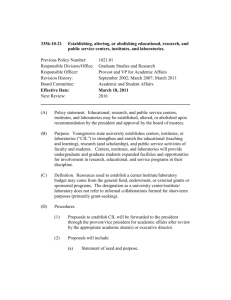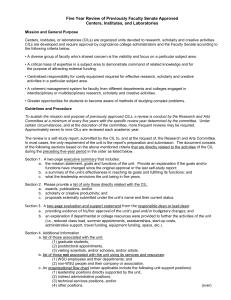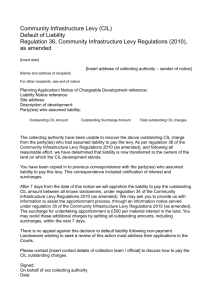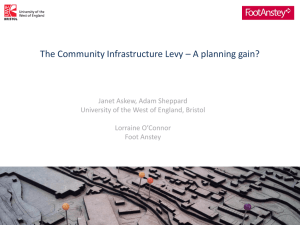Committee report
advertisement
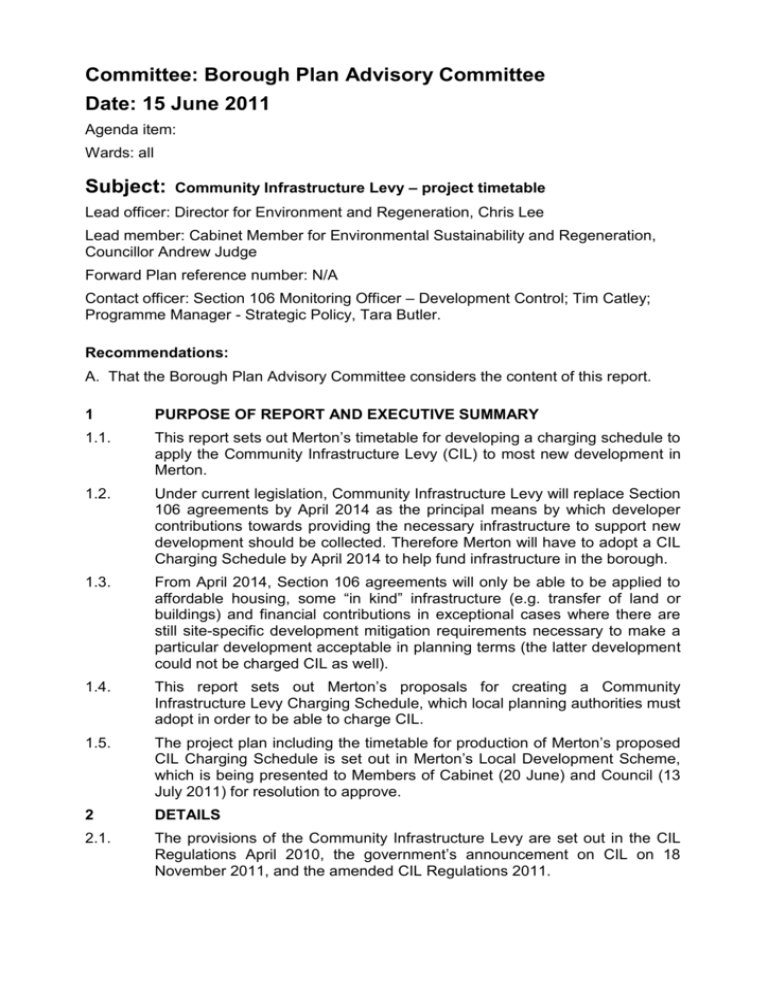
Committee: Borough Plan Advisory Committee Date: 15 June 2011 Agenda item: Wards: all Subject: Community Infrastructure Levy – project timetable Lead officer: Director for Environment and Regeneration, Chris Lee Lead member: Cabinet Member for Environmental Sustainability and Regeneration, Councillor Andrew Judge Forward Plan reference number: N/A Contact officer: Section 106 Monitoring Officer – Development Control; Tim Catley; Programme Manager - Strategic Policy, Tara Butler. Recommendations: A. That the Borough Plan Advisory Committee considers the content of this report. 1 PURPOSE OF REPORT AND EXECUTIVE SUMMARY 1.1. This report sets out Merton’s timetable for developing a charging schedule to apply the Community Infrastructure Levy (CIL) to most new development in Merton. 1.2. Under current legislation, Community Infrastructure Levy will replace Section 106 agreements by April 2014 as the principal means by which developer contributions towards providing the necessary infrastructure to support new development should be collected. Therefore Merton will have to adopt a CIL Charging Schedule by April 2014 to help fund infrastructure in the borough. 1.3. From April 2014, Section 106 agreements will only be able to be applied to affordable housing, some “in kind” infrastructure (e.g. transfer of land or buildings) and financial contributions in exceptional cases where there are still site-specific development mitigation requirements necessary to make a particular development acceptable in planning terms (the latter development could not be charged CIL as well). 1.4. This report sets out Merton’s proposals for creating a Community Infrastructure Levy Charging Schedule, which local planning authorities must adopt in order to be able to charge CIL. 1.5. The project plan including the timetable for production of Merton’s proposed CIL Charging Schedule is set out in Merton’s Local Development Scheme, which is being presented to Members of Cabinet (20 June) and Council (13 July 2011) for resolution to approve. 2 DETAILS 2.1. The provisions of the Community Infrastructure Levy are set out in the CIL Regulations April 2010, the government’s announcement on CIL on 18 November 2011, and the amended CIL Regulations 2011. 2.2. Appendix 1 to this report is the CLG publication in May 2011 “Community Infrastructure Levy – an overview” which gives a useful explanation of the CIL Regulations, what they can be used for and how they will work. CIL Charging Schedule – key points 2.3. Under CIL, local authorities and the Mayor of London will be able to charge a mandatory tariff on a wide variety of development including most new owneroccupied homes and other buildings over 100 sqm. 2.4. CIL will be levied as a charge per square metre of additional (to existing) gross internal floor area (please refer to p.11 para 40 of Appendix 1 for further details). This will make it much more straightforward to calculate in advance for every new development that it applies to. 2.5. Before CIL can be charged, a CIL Charging Schedule must be prepared by the charging authority that, includes community engagement on the potential charge, followed by an independent examination in public and adoption by the Council, under a process very similar to the preparation of LDF documents. 2.6. The CIL Charging Schedule must prove that it is necessary to help bridge any infrastructure funding gap to support growth across the borough over the Core Strategy plan period (2011-26 in Merton’s case). Therefore the background work to preparing the Charging Schedule must be sound infrastructure planning based on the LDF and ensuing viability testing. 2.7. The charging schedule must set out and cost the infrastructure (e.g. new school places, new healthcare facilities etc) needed to support the growth in resident population in Merton over the next 15 years. This infrastructure needs assessment should not include matters that would be necessary to service the existing population (e.g. maintenance of an existing school). 2.8. Merton has an up-to-date infrastructure assessment, completed in 2011, which supported Merton’s sound Core Planning Strategy. 2.9. CIL charges should cover the whole of the local authority area but can have differential charging rates (by area or development type) across the area. 2.10. The setting of those rates must have a sound basis in viability terms so as not to prevent otherwise sound development coming forward. 2.11. Adopting a CIL is not mandatory but changes to S.106 (see below) make it necessary for Merton if the borough is to have the infrastructure needed to support new development. Please refer to paras. 2.31 and 2.32 of this report. 2.12. No other councils have adopted a Charging Schedule at this time; councils including Redbridge, Wandsworth and Portsmouth have published initial proposals for consultation and Newark and Sherwood District Council has submitted its draft Charging Schedule to an independent examiner. Exemptions 2.13. The following are exempt from having to pay CIL: Affordable housing; Where an active (i.e. not long-term vacant) non-residential use is converted into residential and there is no additional gross internal floorspace. Changes of use that do not involve an increase in floorspace (e.g. most dwelling conversions in Merton) Buildings which people do not normally go into or go into intermittently for the purposes of maintenance (e.g. electricity substations; railway signal maintenance sheds). 2.14. Developers may be able to claim for a reduction on the basis of viability in exceptional circumstances in accordance with an exemption procedure should the local authority choose to operate and publish such a procedure. 2.15. As mentioned above, the charging authority may choose or be required to exempt certain areas or types of development from having to pay CIL as a result of the findings of its infrastructure planning, viability assessment or to encourage regeneration if the necessary infrastructure could be funded by other means. Mayor of London’s CIL 2.16. The Mayor of London is preparing a CIL to fund the £300million funding gap towards Crossrail. In the Mayor’s initial CIL consultation in January 2011, charge of £35 per square metre is proposed to be levied on new development (residential and commercial) in Merton to pay for Crossrail. This is the middle of three charging bands: the higher band, including most central London boroughs, Wandsworth and Richmond is proposed at £50 per square metre, the lower band, which includes Croydon and Sutton, is proposed at £20 per square metre. 2.17. Once adopted, boroughs will have to collect the Mayor’s CIL on his behalf and give it priority in calculating the viability of their own CILs. 2.18. For example (assuming no change to initial proposed Charging Schedules), new development in L.B.Redbridge may be expected to provide £105 per square metre: £70 of which would go towards infrastructure within Redbridge and £35 of which would go to the Mayor of London to help pay for Crossrail. 2.19. The Mayor proposes a final consultation on the Mayor’s CIL later in 2011, with the public examination and potential adoption of the Mayor’s CIL by mid 2012. Applying CIL 2.20. Developers have to make CIL payments on a date following commencement of works. Local authorities can decide their own payment deadlines, including payment by instalments if necessary (otherwise a standard 60-day deadline will apply). 2.21. Developers can meet their CIL liabilities in kind (by transfer of land or existing buildings and structures); changes have been made in the amended CIL Regulations 2011 to remove the minimum threshold for payments in kind (made via transfer of land) so even very small in-kind land transfers can count as meeting CIL liabilities. Merton officers consider that this is welcomed as it expands the scope for CIL to be used to unlock land parcels required for infrastructure provision. 2.22. Inspectors acting on behalf of the Secretary of State in their role as examiners of proposed CIL Charging Schedules can’t reject a charging schedule except for an error in law that can’t be corrected. Councils can accept Inspectors’ suggested changes or make their own to address the shortcomings of their schedules without having to go back to the Inspector. These changes will be introduced through provisions in the Localism Bill. Spending CIL 2.23. The CIL Regs. April 2010 allowed CIL to be spent by Charging Authorities on any capital infrastructure. They can be passed to infrastructure providers such as the NHS, Met Police and the Fire Service. Local authorities cannot borrow in advance of CIL receipts. 2.24. The amended CIL Regulations 2011 state that it will be mandatory for “neighbourhoods” to be given a “meaningful proportion” of CIL revenues. CLG publication entitled “Community Infrastructure Levy – an Overview” May 2011, advises that this means that some CIL monies for the neighbourhoods must be passed to them by Councils – i.e. not spent by councils on behalf of neighbourhoods. This doesn’t apply to the Mayoral CIL. 2.25. While the meaning of “neighbourhoods” and “meaningful proportion” is undefined in the amended CIL Regulations 2011 or any other guidance on CIL, it is unclear what the impact of this proposal will be. There are some concerns regarding the legal implications for receipt and disposal of funding for infrastructure, and the extent of the impact on the infrastructure funding gap. 2.26. The Localism Bill (first reading 13 December 2010, due to become law by April 2012) will amend the Planning Act 2008 to allow for Regulations to be changed in the following manner: - To specifically allow or prohibit CIL revenues to be spent on maintenance, operational and promotional activities. To date, no advice has been provided by CLG regarding the intention of this change so we will need to wait for updated advice and/or any amendments to the Regulations and CIL Guidance. If the Regulations were to make provision in favour of such revenue type expenditure then this would significantly expand the scope for spending CIL to such measures as town centre management, and notably infrastructure operation (e.g. salaries for those working in schools or healthcare.) If the scope for spending CIL would be expanded to such an extent there is a concern that this would be too far a departure from the intention of and justification for CIL, namely to fund the infrastructure necessary to support the growth over the plan period set out in the LDF. - To allow for the expenditure of CIL revenue on future ongoing costs associated with the capital infrastructure projects funded by CIL. There has been no advice provided by CLG regarding the intention of this change so we will need to wait for changes to the relevant regulations and other advice. This is currently being interpreted to mean that CIL could be spent on, for example, a project manager to deliver a new school development (where the school was funded by CIL). 2.27. If it was decided to take up this facility then project management costs for both local Councils and Neighbourhoods might be CIL fundable. It is noted that further expansion of the scope for spending CIL as per paragraphs 2.26 above would impact upon the amounts that might be available for any particular project. This is because there is a finite capacity of development to generate CIL revenues. The Case for a Merton CIL 2.28. As Merton will have to adopt a CIL Charging Schedule by April 2014 to replace most S106 in helping fund infrastructure in the borough, t is recommended that the council starts preparations towards this. Paragraph 5.1: below sets out the proposed timetable for carrying out this work. 2.29. It is considered that there are no reasonable alternative options to help fund infrastructure associated with a growing population and new development beyond 2014, other than take forward a CIL Charging Schedule. 2.30. The CIL Regulations 2010 and 11 make Section 106 obligations illegal unless they are: (a) necessary to make the development acceptable in planning terms; (b) directly related to the development; and (c) fairly and reasonably related in scale and kind to the development 2.31. The Regulations also provide a transitionary period (to 6 April 2014 or, by the date of the introduction of a local CIL, whichever the earlier) after which it would be impossible for local authorities to use S.106 like a tariff. 2.32. In other words by 6 April 2014 it would be unlawful the Council to require s.106 contributions to be pooled to provide new infrastructure such as education, open space/play space, sustainable transport projects as is done currently. 2.33. Once the initial preparations and viability testing has been carried out officers will have a better idea as to how the amount of revenue that may be generated from CIL receipts would compare with S.106 revenue. While it is anticipated that the benefits of adopting a CIL earlier outweigh the disbenefits, the date for adoption/publication could be delayed to a date closer to the 6th of April 2014 (but no later) should it be preferable to continue operating the existing S.106 regime for as long as possible. 3 ALTERNATIVE OPTIONS 3.1. As set out in paragraphs 2.29-32 above, it is considered that there are no reasonable alternative options to help fund infrastructure associated with a growing population and new development beyond 2014, other than take forward a CIL Charging Schedule. 4 CONSULTATION UNDERTAKEN OR PROPOSED 4.1. Consultation is proposed to inform the preparation of Merton’s CIL Charging Schedule as set out in Section 5 below. 5 TIMETABLE 5.1. The proposed timetable for Merton to produce a CIL Charging Schedule is as follows: Preparation and viability testing – September-December 2011 Community engagement on draft Merton CIL Charging Schedule – JanFeb 2012 Finalise Merton CIL Charging Schedule – summer 2012 Final community engagement on CIL: September-November 2012 Submit for independent examination: January-February 2013 Independent examination – public hearings – April/May 2013 Adoption – July/October 2013 6 FINANCIAL, RESOURCE AND PROPERTY IMPLICATIONS 6.1. As set out in the body of the report, from April 2014 CIL will replace most S106 agreements in funding infrastructure associated with new development. As set out in paragraphs 2.28-2.33 above, CIL will be the only mechanism for collecting funds to support new infrastructure where these funds are pooled, e.g. for open space, play space, sustainable transport and education. 6.2. For example, as set out in Merton’s Annual Monitoring Report 2009-10 (chapter 13) in the three financial years between April 2007 and March 2010 Merton Council agreed monetary Section 106 amounting to approximately £2,440,000 for educational contributions, £1,344,920 for open space and leisure. Although some of these contributions are site specific, however many of them are pooled to cover areas in the vicinity of several developments. Without an adopted CIL charging schedule, this would not be possible from April 2014. 7 LEGAL AND STATUTORY IMPLICATIONS 7.1 The power to charge CIL is contained within Part 11 (Section 205-225) of the Planning Act 2008 (“the Act”), the Community Infrastructure Levy Regulations 2010 and the amended Community Infrastructure Levy Regulations 2011. CIL is defined as an imposition of a charge; the purpose of which is to ensure costs incurred in providing infrastructure to support development of the area can be funded (wholly or partly) by owners or developers of land (Section 205(1) and (2) of the Act). 7.2 It should be noted that a charging authority cannot adopt CIL unless it has first produced a charging schedule and must only implement CIL in reliance on an up-to-date development plan. Merton’s Core Planning Strategy is recommended for adoption at the meeting of full Council on 13 July 2011. 7.3 A charging authority must approve the charging schedule at a meeting of the authority and by a majority of votes of members present. There are requirements in the CIL Regulations and the Act relating to appeals against the application of CIL and the enforcement of CIL. 7.4 On 18 November 2010, the government announced that CIL will be retained and reformed via regulations associated with the Localism Bill so that neighbourhoods may receive a proportion of funds raised by Councils as part of CIL. When these Regulations are published, they will guide legal issues surrounding the third party expenditure of CIL funds. 8 HUMAN RIGHTS, EQUALITIES AND COMMUNITY COHESION IMPLICATIONS 8.1 Adoption of the levy would allow the Council, and potentially local neighbourhoods, to target the resulting revenue stream towards those types of infrastructure considered necessary to meet the needs of different areas. This is a key point in terms of delivering equality and diversity through the Council’s services. Consequently, the levy is potentially a very positive development. 9 CRIME AND DISORDER IMPLICATIONS 9.1. CIL will replace Section 106 agreements in helping to fund the infrastructure necessary to mitigate crime and disorder issues arising from new development. 10 RISK MANAGEMENT AND HEALTH AND SAFETY IMPLICATIONS 10.1. None for the purposes of this report 11 APPENDICES – THE FOLLOWING DOCUMENTS ARE TO BE PUBLISHED WITH THIS REPORT AND FORM PART OF THE REPORT 12 Appendix 1 - CLG: “Community Infrastructure Levy – an overview” BACKGROUND PAPERS - CLG “Community Infrastructure Levy – an overview” (May 2011) - CIL Regulations 2011 (April 2011) - Government announcement on CIL (18 November 2010) - CIL Regulations 2010 (April 2010) - Merton’s Annual Monitoring Report 2009-10




